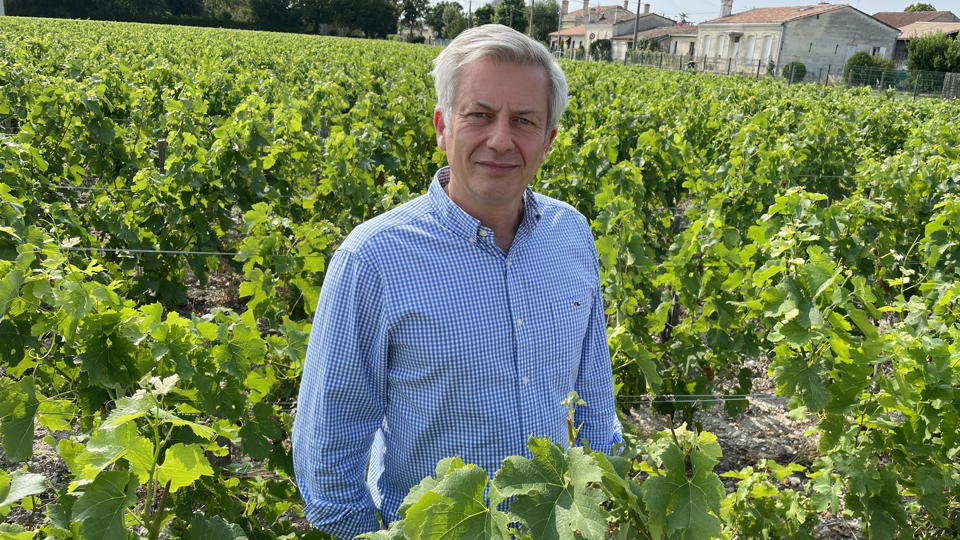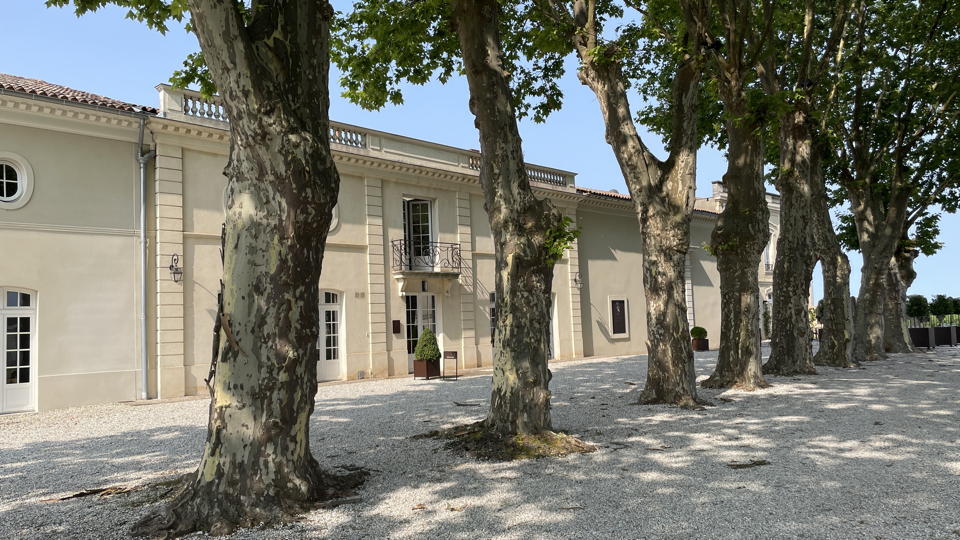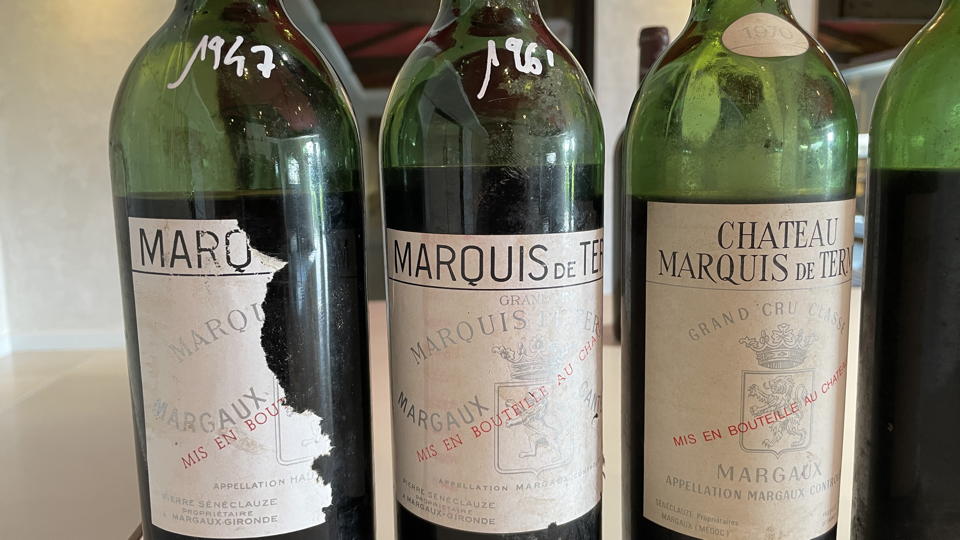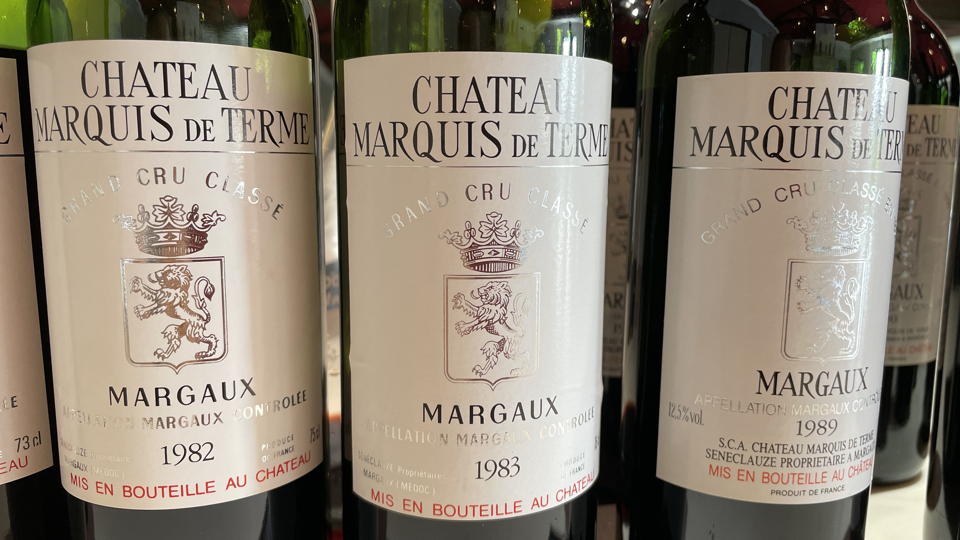Browse using the new Vinous website now. Launch →
Printed by, and for the sole use of . All rights reserved © 2015 Vinous Media
The Misunderstood Margaux: Marquis de Terme 1947-2021
BY NEAL MARTIN | OCTOBER 08, 2024
The blood in the Médoc’s veins has run blue since time immemorial. Thank the Baron and Comtesse of Pichon, the Marquis d’Alesme and the subject of this article, Marquis de Terme. Last year Ludovic David, chief executive of the classified Fourth Growth, invited me to the Margaux château for a private vertical tasting. He did not specify the timespan. Just the last decade would have been useful. But entering the spacious tasting room, my eyes set upon an array of vintages back to the post-war period. I readied my taste buds and diligently worked my way through the wines, penned my notes, and then they were overwhelmed by the deluge of deadlines and other articles demanding completion. The recent announcement of David’s departure prompted me to return to my spreadsheet, research the background and author a piece on this oft-overlooked wine.
History
The genesis of Marquis de Terme dates back to 1762 when Mme. Ledoux d’Emplet, either the niece or grand-niece of Pierre Rauzan, married François de Peguilhem de Larboust, aka the Marquis de Terme. Her dowry included land cleaved away from the vast Rauzan estate that was named after her husband, though Clive Coates, writing in his Grand Vins tome, posits another theory that it was an amalgam of small vineyards. In 1787, the future president of the United States and then ambassador, Thomas Jefferson, stayed at Marquis de Terme and ranked its wine as a Third Growth in his own unofficial classification.
Proprietorship is a little convoluted. After the passing of the Marquis, the château was bought by a Swedish Bordeaux négociant, Halvorous Sollberg, for 32,000 Francs in 1809. He hired a winemaker named Thomas Feuillerat, whose family made the wine for over a century. Sollberg ran into financial difficulties and, in 1834, fled to Argentina, after which the estate was divided. Monsieur Mac-Daniel took over Marquis de Terme, though it is alleged that he was embroiled in a love affair with Sollberg’s wife. Coates suggests this was all a ruse in order for the Sollbergs to retain ownership once they had settled their debts. This was accomplished in 1845, whereupon their son, Oscar Sollberg, took over the estate, as well as Château Siran.
Ludovic David out in the vines last summer. I must admit I’ll be sad to see him go as he has done a great deal for the estate.
Unfortunately, the Sollbergs ran into financial troubles for a second time, and the estate was put up for sale. Jean Feuillerat, Thomas's son, had worked his way up to régisseur, and wanted to buy the property. However, lacking the financial means, Feuillerat’s friend, Frédéric Eschenhauer, bought it. Perhaps in some ways repeating the role played by Mac-Daniel, it could be said that he safeguarded Marquis de Terme until Feuillerat could raise the capital. This was done in 1898, by which time he had sufficient funds to buy Pontac-Lynch, while his own son Armand went on to acquire Château Ferrière in 1913.
When Armand Feuillerat died in 1935, Marquis de Terme was bought by a Marseille merchant, Pierre Sénéclauze, at auction. It was later inherited by his sons Pierre-Louis, Philippe and Jean. The wines were not as prominent as other Grand Cru Classés, mainly because they were sold directly to the market instead of via the Place de Bordeaux. Furthermore, its wines were not well-regarded. Stephen Brook, writing in The Complete Bordeaux, interviewed Jean-Pierre Hogan, the laconic cellar master since 1974, who did not deny excessively high yields and lack of cellar hygiene. Some said that the wine could be excessively tannic.
In 2009, Hugon retired, and Ludovic David was appointed to run the estate. Born in Cherbourg, he had previously worked at Clos du Clocher and Bonalgue. Under David, the estate invested in the winery and improved its vineyard husbandry and vinification, particularly in terms of sorting at reception. I always found him a very congenial and open estate director, and under his charge, the property also invested in oeno-tourism, opening their restaurant doors in July 2021. You could argue that Marquis de Terme caters to tourists more than any other Left Bank château.
The château consists of several single or double-storey outbuildings. This is the discrete entrance.
The Vineyard
The vineyard presently covers around 40 hectares split amongst 39 parcels around the appellation, mostly in the commune of Margaux but also in Cantenac, Soussans and Arsac. Only 5.5 hectares surround the château building. I asked David to give me a brief rundown of their holdings. "We are in the middle of the village of Margaux,” he told me. “The main part of the Cabernet Sauvignon is located on gravel soils next to Château Lascombes. There is another three-hectare parcel next to the château and Rauzan-Ségla. We share a 12-hectare parcel of gravel and limestone with Palmer on the slope between the road and the wall around d'Issan that is planted with Merlot. We consider it to be a historical vineyard insofar that it is the same as it was in 1855. It has a very homogenous terroir, so we can produce 80% to 85% Grand Vin.”
The current composition of plantings is 59% Cabernet Sauvignon, 36% Merlot and 5% Petit Verdot; the vines are worked organically. I believe older vintages comprise much less Merlot and a little more Petit Verdot. David explained that the wine is fermented in concrete vats: “We do vinification intégrale in the Quintessence barrels. We have around 110 of them, and they are perfect for infusion. We put a pressure control on the bottom of the barrel so that we can control the CO2 and maceration.” The Grand Vin is aged in oak and 600-liter Nomblot concrete eggs for between 16 to 18 months, with around 50% new oak.
The
Wines
Reading wine literature, it was interesting to note that even the most seasoned writers, past and present, have relatively little first-hand experience of Marquis de Terme. Perhaps its reputation discouraged investigation? I don’t know. I was in the same boat, my notebooks with few scribblings of older vintages. The château does have a small library of old vintages; Ludovic David informed me that the oldest resident is the1928.
Broaching
from oldest to younger. I am taken aback by the quality of the 1947 Marquis
de Terme. This vintage can be hit and miss, but this bottle has held up
extremely well. As expected, it has a little VA, yet it is harmonious and quite
delicious. Profound? No. But it deserves a round of applause. The 1961
Marquis de Terme is perhaps a little disappointing by comparison, and there
is dryness on the finish. It’s no slouch, just a bit conservative, and it is missing
fireworks. Despite being a little staid on the nose, the 1970 Marquis de
Terme is another surprise, yet with admirable depth and sufficient vestiges
of fruit to surpass the 1961. The 1971 and 1975 both attest to
high yields that diluted quality, but the 1982 Marquis de Terme and, for
that matter, the 1983, are drinking well, though the latter should not
be cellared long-term. The hidden gem was the 1989 Marquis de Terme,
vivacious and boasting more body than the 1982, with hints of clove on the
finish. I served another bottle blind to a friend who was shocked when I
revealed the château. It shows better than the tertiary and slightly high-toned
1990.
Moving
into the modern era, we focused on the best vintages like 2005, 2009
and 2010. These are solid Margaux wines, which are not spectacular but
certainly better than I expected. David explained: “The 2009 vintage was the first
without using pumps. We pushed down the cap manually. We still had large tanks,
so it was difficult in terms of the selection. This was also the first vintage where
we used a real sorting table.”
The true surprise is how well the 2011 Marquis de Terme shows, which is far superior to the disappointing 2012. Perhaps that is the problem…consistency. Fortunately, this was the year when they began to renovate the cellar, introducing temperature regulation in the vats using glycol or water. This project was finished in 2017. Recent vintages have translated the improvements made at the estate, especially the 2016, 2019 and 2020, the latter confirmed by its impressive showing at the Southwold tasting last January.
Final
Thoughts
This was an insightful tasting of Marquis de Terme. I must confess that I approached the vertical without any preconceptions. Still, several of the more mature bottles surpassed my expectations, suggesting that criticisms of the past are not well founded. Maybe Marquis de Terme has been misunderstood? My suspicion is that its more tannic wines simply took a longer time to come around compared to other, more approachable Margaux. Perhaps Marquis de Terme steps to a slightly different beat. David told me that due to the lower clay content in the vineyard, more rain is needed to prevent hydric stress, which can delay ripeness. Obviously, David’s unexpected departure means that Marquis de Terme's future is uncertain. In the past, I sensed some frustration from the estate for the lack of recognition their wines received among their peers. However, this tasting suggests that higher quality is achievable for whoever navigates the boat into the future.
© 2024, Vinous. No portion of this article may be copied, shared or re-distributed without prior consent from Vinous. Doing so is not only a violation of our copyright, but also threatens the survival of independent wine criticism.
You Might Also Enjoy
Poetic License: Siran 1920-1929, Neal Martin, October 2023
Margaux Focus 2: Château Palmer, Neal Martin, August 2023
The Margaux Paragon: Rauzan-Ségla 1900-2015, Neal Martin, April 2019





